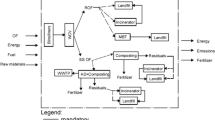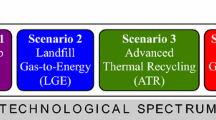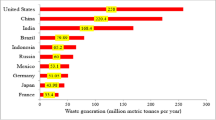Abstract
The required minimum 30-year post-closure care period for municipal solid waste (MSW) landfills can be shortened by reducing or eliminating of MSW components with long-terms effect in gas and leachate. The objectives of this study were to evaluate the relative persistence of landfill gas, leachate quantity, and selected leachate parameters using post-closure monitoring data from a case study landfill in south Florida. The relative persistence of selected decomposition byproducts in leachate were evaluated by both zero order and first order models based on monitoring data from the case study landfill. The analyses show that although gas and leachate production rates diminish very quickly, some contaminants remain in leachate as the decomposition process continues at a slower rate. For the case study landfill, the parameters which have been detected consistently at high concentrations (above MCL) included chloride, TDS, iron, bicarbonate, benzene, and vinyl chloride. Among these, vinyl chloride has the fastest and TDS has the slowest rate of disappearance in the landfill environment. The effect of waste diversion on persistence times of the selected persistent leachate quality parameters was evaluated. For example, a 40% reduction in the amount of plastics deposited in the landfill could reduce the monitoring time for benzene from 59 to 39 years. Zero order model underestimates the persistence times of the contaminants in leachate due to its linear nature. Shortening the monitoring times can provide significant savings for municipalities who need to continue monitoring leachate quality until the MCL levels are reached.







Similar content being viewed by others
References
Baedecker, M. J., & Back, W. (1979). Hydrogeological process and chemical reactions at a landfill. Groundwater, 17, 429–437.
Barlaz, M. A., Schaefer, D. M., & Ham, R. K. (1989). Bacterial population development and chemical characteristics of refuse decomposition in a simulated sanitary landfill. Applied and Environmental Microbiology, 55(1), 55–65.
Breslin, V. T. (1993). Degradation of starch-plastic composites in a municipal solid waste landfill. Journal of Polymers and the Environment, 1(2), 127–141.
Deutsch, W. J. (1997). Groundwater geochemistry: Fundamentals and applications to contamination. Boca Raton, FL: CRC Press.
Ham, R. K., Fritschel, P. R., & Norman, M. R. (1993). Refuse decomposition at a large landfill proceedings Sardinia 93, fourth international landfill symposium (pp. 1046–1054). Cagliari, Italy: CISA, Environmental Sanitary Engineering Centre.
Kjeldsen, P., Barlaz, M. A., Rooker, A. P., Baun, A., Ledin, A., & Christensen, T. H. (2002). Present and long term composition of MSW landfill leachate: A review. Critical Reviews in Environmental Science and Technology, 32(4), 297–336.
Lee, G. F., & Jones, A. R. (1991). Groundwater pollution by municipal landfills: Leachate composition, detection and its water quality significance. In Proceedings of the national water well association fifth national outdoor action conference, Las Vegas, NV.
Micales, J. A., & Skog, K. E. (1997). The decomposition of forest products in landfills. International Biodeterioration & Biodegradation, 39(2–3), 145–158.
Sizirici, B., & Tansel, B. (2010). Projection of landfill stabilization period by time series analysis of leachate quality and transformation trends of VOCs. Waste Management, 30(1), 82–91.
Solcomhouse. (2009). Degradation rates for compounds was accessed from, http://www.solcomhouse.com/recycling.htm. May 2009.
Statom, R. A., Thyne, G. D., & McCray, J. E. (2004). Temporal changes in leachate chemistry of a municipal solid waste landfill cell in Florida. USA Environmental Geology, 45, 982–999.
Tansel, B., Sizirici, B., Reinhart, D. R., & Kulkarni, A. (2008). Performance based decision system for determining post-closure care (PCC) period in Florida landfills final report. Gainesville, FL: Hinkley Center for Solid and Hazardous Waste Management.
University of Nebraska-Lincoln Extension bulletin. (2009). G90-959, household waste management. http://www.msue.msu.edu/objects/content_revision/download.cfm/revision_id.498908/workspace_id.-4/01500582.html/. June, 2009.
U.S. Congress, Office of Technology Assessment. (1989). Facing America’s trash: What next for municipal solid waste. Washington, DC: U.S. Government Printing Office, OTA-O-424.
Wang, Y. S., Byrd, C. S., & Barlaz, M. A. (1994). Anaerobic biodegradability of cellulose and hemicelluloses in excavated refuse samples using biochemical methane potential assay. Journal of Industrial Microbiology & Biotechnology, 13(3), 147–153.
Wisconsin Department of Natural Resources. (2007). Waste and materials management program guidance for landfill organic stability plans NR 514.07(9), Wisconsin Adm. Code Publication WA-Publication.
Acknowledgments
Partial funding for this research was provided by Hinkley Center for Solid and Hazardous Waste Management and Florida International University Dissertation Year Fellowship.
Author information
Authors and Affiliations
Corresponding author
Additional information
Readers should send their comments on this paper to BhaskarNath@aol.com within 3 months of publication of this issue.
Rights and permissions
About this article
Cite this article
Tansel, B., Yildiz, B.S. Goal-based waste management strategy to reduce persistence of contaminants in leachate at municipal solid waste landfills. Environ Dev Sustain 13, 821–831 (2011). https://doi.org/10.1007/s10668-011-9290-z
Received:
Accepted:
Published:
Issue Date:
DOI: https://doi.org/10.1007/s10668-011-9290-z




